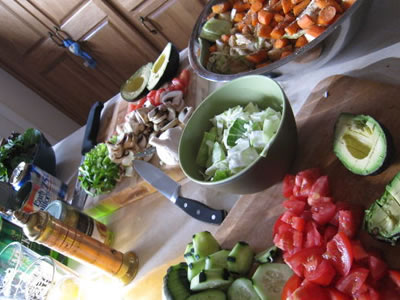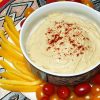The way you cook for a person with diabetes is the way you should cook for the whole family. By cutting down the fat, sugar, and sodium in recipes, you lower everyone's risk for diabetes and other chronic diseases.
Use of Sugar and Artificial Sweeteners
- In some recipes, sugar can be safely cut by 1/4 to 1/3. Cookies and cakes may not turn out as well when the sugar is reduced.
- Artificial sweeteners work best in foods that do not need sugar for color, texture, or moistness.
- For the best recipes made with less sugar or an artificial sweetener, use a good diabetic cookbook or recipes from companies that make artificial sweeteners.
- You can substitute small amounts of sugar for other carbohydrates in the diet. But use foods high in sugar very seldom, as they only have empty calories.
Cutting the Fat and Sodium
- Eat very little fried food.
- Bake, broil, grill, boil, poach, and roast.
- Trim all meat well. Remove skin and fat from poultry.
- Season vegetables with fat-free, low-sodium broth rather than fatback, margarine, oil, or butter.
- Cook in a nonstick pan or skillet.
- Use a nonstick vegetable spray on pots and pans.
- Switch to reduced-fat tub or liquid margarine.
- Sprinkle on lemon juice, herbs, and spices instead of salt or fat for flavor.
- Use reduced-fat and fat-free foods carefully. Some are high in calories from sugar or other carbohydrates. Many are also high in sodium.
- Eat more low-calorie vegetables instead of large portions of meat, poultry, or fish.
- Have fruit for dessert.
- Use nonfat or reduced-fat milk, cheese, and sour cream.
- Use reduced-fat salad dressing and mayonnaise, or cut regular dressing in half with plain nonfat yogurt.
- Cut the fat or oil in a recipe by 1/4 to 1/2.
Portion Control
- Measuring cups and spoons and a small scale for weighing food will provide the best portion control. After practicing 2 to 3 weeks, you may need to carefully measure portions only when you try a new food or when blood sugars or weight go out of control.
- Always use the same size plate, bowl, cup, and glass to make it easier to eyeball portion sizes.
- The palm of an average woman's hand equals about 4 ounces or 1/2 cup. A woman's fist is about the size a piece of fresh fruit or a potato should be.
- Serve portions on the plate in the kitchen, to cut down on second helpings. Good diabetic cookbooks are available from the American Diabetes Association (ADA).
ADA









